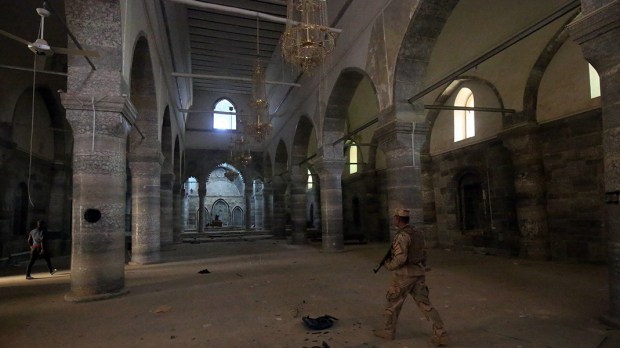Mosul’s basic infrastructure will cost more than $1 billion to repair after the U.S.-backed Iraqi offensive to retake the city from the Islamic State group, the New York Times reported a senior U.N. official saying Wednesday.
But one structure that won’t need much more than a cleaning up is a centuries-old church named in honor of St. Thomas the Apostle.
As Iraqi and coalition forces get closer to victory over ISIS in Iraq’s second-largest city after an eight-month campaign, the world is coming to see the widespread destruction left by coalition bombing. But also, there is deliberate destruction carried out by the retreating forces.
There is, for example, the Great Mosque of al-Nuree, considered one of the main historical mosques in Iraq, and its iconic leaning minaret known as al-Hadba (the hunchback), which ISIS destroyed in late June. It is the mosque where Abu Bakr al-Baghdadi called on followers to establish a caliphate in 2014, the first formal declaration of the Islamic State of Iraq and Syria.
But just a couple of blocks away from that mosque is St. Thomas Church, the oldest church in the city. Thankfully–some say miraculously–it suffered only “a few scuff marks” on the outside, while the interior suffered minimal damage.
“It has existed since the end of the eighth century, but is considered much older and was founded in the place where the Apostle of the East is believed to have lived while passing through the city,” AsiaNews reported. “The interior was devastated by the occupants who had made it a military base. But the monument, whose structure dates back to at least the 13th century, survived the battle.”
Mosul: The miracle of the church of St. Thomas, spared of Isis bombs https://t.co/ILmkQe9itS#AsiaNews@LOrientLeJourpic.twitter.com/nV0EvzthfW
— AsiaNews EN (@AsiaNewsEN)
July 3, 2017
AsiaNews described a tour given its reporter by a local fighter, 23-year-old Ahmad Kathem. Fair warning: it’s a bit gory:
Ahmad forces an iron gate to show the interior of the church. Compared to the surroundings devastated by bombs, the wounds of the Christian building are just mere scratches. The courtyard which Ahmad enters is littered with stones and rubbish, but the columns of the arches surrounding him are intact. On a bas-relief, Saint Thomas touches the wounds of Christ. Their faces are shrouded in a superficial way. Next, a body rotates under a pile of rubbish. In the middle of an adjacent courtyard, a second corpse emanates odor, obese and with a thick black beard, eyes popping out of swollen orbits. His face a blur of gunshot wounds, projecting splashes on the ground around his skull forming a bloody crown. Behind him, barrels and grain bags are all that remains of terrorists’ stocks. A room is still full of military clothes and AK-47 chargers. Inside, a bomb pierced the vault of the main nave. A ray of light falls on the devastated interior. The benches are burnt. Under its arch, the altar is in pieces.
The report notes that ISIS militants had “drawn black circles on the thick dark marble columns, no doubt in preparation for the destruction of the church. They did not have the time or the way to place their explosives.”
Just over three years ago, when ISIS took over the city, the church transferred the relics of St. Thomas to the Syrian Orthodox monastery of St. Matthew, outside Mosul. At the time, Fides news agency reported that the Syrian Orthodox Church invokes the saint to spare the Iraqi people from further suffering.

